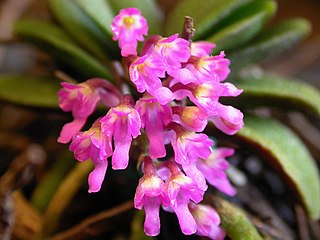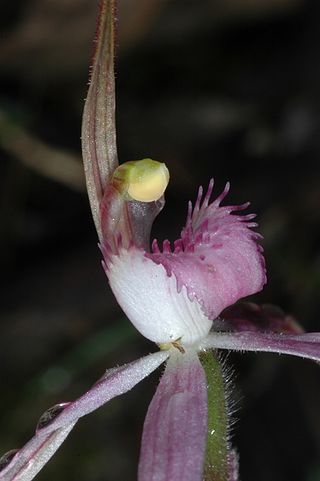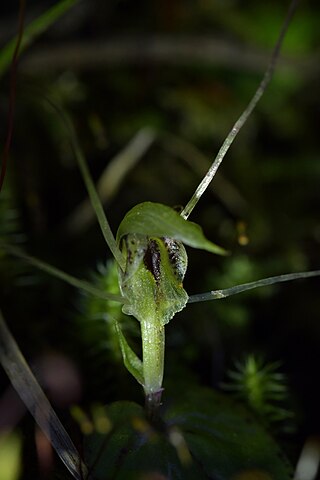
Cymbidium, commonly known as boat orchids, is a genus of evergreen flowering plants in the orchid family Orchidaceae. Orchids in this genus are epiphytic, lithophytic, terrestrial or rarely leafless saprophytic herbs usually with pseudobulbs. There are usually between three and twelve leaves arranged in two ranks on each pseudobulb or shoot and lasting for several years. From one to a large number of flowers are arranged on an unbranched flowering stem arising from the base of the pseudobulb. The sepals and petals are all free from and similar to each other. The labellum is significantly different from the other petals and the sepals and has three lobes. There are about fifty-five species and sixteen further natural hybrids occurring in the wild from tropical and subtropical Asia to Australia. Cymbidiums are well known in horticulture and many cultivars have been developed.

In botany, the labellum is the part of the flower of an orchid or Canna, or other less-known genera, that serves to attract insects, which pollinate the flower, and acts as a landing platform for them.

Prasophyllum, commonly known as leek orchids, is a genus of about 140 species of flowering plants in the orchid family, Orchidaceae and is found in Australia and New Zealand. The Australian species are found in all states but have not been recorded in the Northern Territory. The common name arises from their having a hollow, leek- or onion-like leaf. Some species only flower after summer fires and have flowers similar to those of Xanthorrhoea which flower at the same time, suggesting that they employ the same pollinating insects. Leek orchids are similar to those in the genus Genoplesium except that the free part of the leaf is cylindrical and the labellum has a solid connection to the column. They range in size from the little laughing leek orchid at about 15 cm (6 in) to the king leek orchid which grows up to 2 m (80 in) tall.

Gastrodia, commonly known as potato orchids or as 天麻属 , is a genus of terrestrial leafless orchids in the family Orchidaceae, about ninety of which have been described. Orchids in this genus have fleshy, upright stems and small to medium-sized resupinate flowers with narrow sepals and petals. They are native to Asia, Australia, New Zealand, central Africa, and various islands of the Indian and Pacific Oceans.

Gastrodia elata is a saprophytic perennial herb in the family Orchidaceae. It is found in Nepal, Bhutan, India, Japan, Korea, Siberia, Taiwan, and China.

Corymborkis, commonly known as cinnamon orchids, or 管花兰属 is a genus of eight species of orchids in the family Orchidaceae. They are evergreen, terrestrial plants which grow in clumps and have thin roots, leafy stems, pleated leaves and widely-opening flowers with thin, spreading sepals and petals. They are widely distributed in the tropics.

Eriochilus, commonly known as bunny orchids, is a genus of flowering plants in the orchid family, Orchidaceae that is endemic to Australia. Orchids in this genus are distinguished from those in the similar Caladenia by having a glabrous leaf and a densely woolly labellum. Species occur in south-west Western Australia, South Australia, Queensland, New South Wales, the Australian Capital Territory, Victoria, and Tasmania. Their common name alludes to their prominent ear-like lateral sepals.
Resupination is derived from the Latin word resupinus, meaning "bent back with the face upward" or "on the back". "Resupination" is the noun form of the adjective "resupine" which means "being upside-down, supine or facing upward".

Schoenorchis, commonly known as flea orchids, or 匙唇兰属 in Chinese, is a genus of flowering plants from the orchid family, Orchidaceae. Plants in this genus are small epiphytes with thin roots, thin leafy stems with leaves in two ranks and tiny fragrant, almost tube-shaped flowers with a prominently spurred labellum. There are about twenty five species found from tropical and subtropical Asia to the Western Pacific.

Rhomboda, commonly known as velvet jewel orchids, is a genus of about twenty species of flowering plants in the orchid family Orchidaceae. Plants in this genus are mostly terrestrial herbs with a fleshy, creeping rhizome and a loose rosette of green to maroon coloured leaves. Small resupinate or partly resupinate, dull coloured flowers are borne on a hairy flowering stem. The dorsal sepal and petals overlap and form a hood over the column and there is a deep pouch at the base of the labellum. They are found in tropical regions from northern India through Southeast Asia, China, Japan to Australia and some Pacific Islands.
Pterostylis procera, commonly known as the short-lipped greenhood, is a species of orchid endemic to Queensland. It has a rosette of leaves and when flowering a single translucent white flower with green and reddish markings and a labellum which does not protrude through the lateral sepals.
Prasophyllum hectori, commonly known as the swamp leek orchid, is a species of orchid endemic to New Zealand. It has a single tubular, dark green leaf and up to eighty scented, yellow-green flowers with red or brown marking. It is similar to P. colensoi, the only other species of Prasophyllum found in New Zealand, but is distinguished from it by its larger size, larger number of flowers and swampy habitat.

Prasophyllum striatum, commonly known as the streaked leek orchid, is a species of orchid endemic to New South Wales. It has a single thin, tube-shaped leaf and up to ten greenish and whitish flowers with reddish or purplish stripes. It differs from other leek orchids in having a very thin leaf and prominently streaked flowers.
Cheirostylis ovata, commonly known as the banded fleshy jewel orchid, is a species of orchid that is endemic Queensland where it grows in rainforest and moist woodland. It has between three and seven egg-shaped leaves and up to six small white flowers with two lobes on the end of the labellum.
Gastrodia queenslandica, commonly known as rainforest bells, is a leafless terrestrial mycotrophic orchid in the family Orchidaceae. It has one or two small, yellowish brown, tube-shaped flowers on a thin, brittle flowering stem and grows in rainforest in tropical north Queensland, Australia.

Caladenia rosea, also known as pink primrose orchid, is a plant in the orchid family Orchidaceae and is endemic to relatively inaccessible, high lateritic plateaux in a high rainfall area in south-western Western Australia. It is a terrestrial orchid with a single hairy leaf and up to three pink flowers on a thin, sparsely-hairy stem. It is similar to Caladenia flava but is distinguished by the perianth being pink to dark pink with prominent red striping and spotting on the dorsal sepal and lateral petals. Caladenia rosea mimics Hypocalymma robustum (Myrtaceae) in terms of flowering time, colour and scent.
Gastrodia zeylanica is a species of potato orchids which is endemic to Sri Lanka. It was added to the 2007 Red list of Threatened Fauna and Flora of Sri Lanka as 'critically endangered', on the basis of it having only been collected from a few localities.
Gastrodia spatulata is a species of Gastrodia native to Indonesia and Malaysia. It is known from Borneo and Java.

Corybas trilobus is a species of terrestrial orchid endemic to New Zealand. It is part of the C. trilobus aggregate, whose members are characterized by a funnel or dish-shaped labellum and an often heart or kidney-shaped solitary leaf.

Corybas papa is a species of terrestrial orchid endemic to the North Island of New Zealand. It has a solitary wedge-shaped leaf and single translucent green flower with a strongly deflexed labellum and slender, threadlike lateral sepals and petals.











